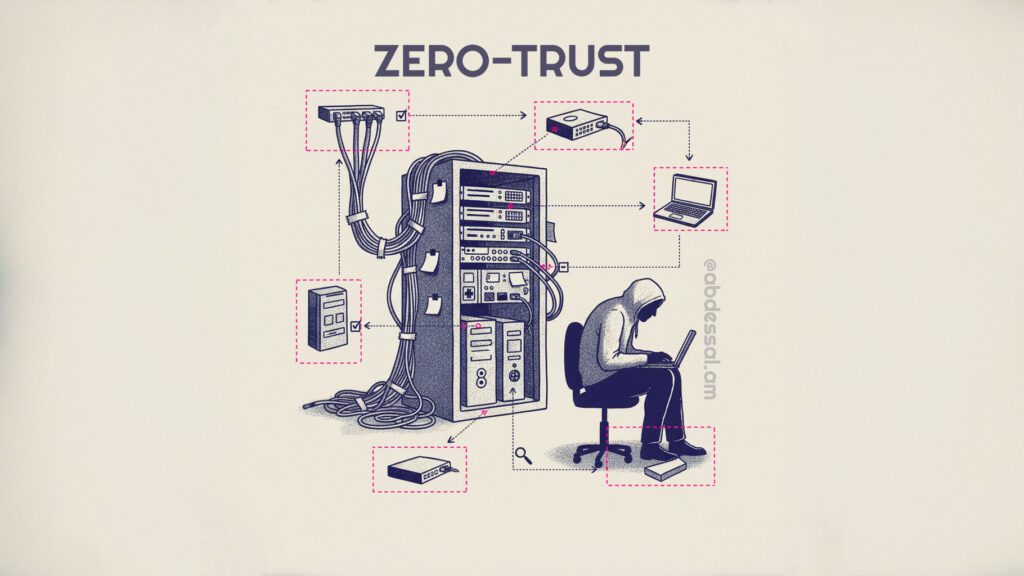
The internet doesn’t care if you’re a one person shop renting a couple of VMs or a tech giant with a billion-dollar security budget. It will still kick your door in the second you leave it cracked open. That’s not me being dramatic; that’s literally what’s happening out there. Every new VM, every exposed port, every half-configured service is instantly scanned, probed, and if you’re unlucky/exploited.
The internet is hostile by default
For years, our answer to this problem was simple: build a wall. Throw a firewall at the edge of the network, let trusted stuff sit safely “inside,” and keep the barbarians out. This was the perimeter security model, and it worked right up until it didn’t. Today, cloud hosting has made that model laughably fragile. Resources come and go in minutes, credentials leak faster than they can be rotated, and attackers don’t storm your gates, they just log in.
That’s where zero-trust comes in. And if you’re serious about running anything on the internet today, whether it’s a hosting service, a SaaS app, or even just a personal project. You can’t ignore it.
The Perimeter Is Dead (and We Killed It Ourselves)
Think about how hosting looked in 2005: servers racked in a datacenter, one chunky firewall at the edge, maybe a VPN for admins. The assumption was that once you got inside that fence, you were safe.
Fast forward to 2025. That assumption is gone. Why?
- Credentials are the new crowbar. Verizon’s Data Breach Investigations Report 2025 shows that in basic web app attacks, a staggering 88% involve stolen credentials. In other words, attackers aren’t breaking down walls, they’re walking in with the right keys.
- Encryption isn’t a differentiator anymore. Mozilla’s telemetry shows HTTPS went from a minority (under 30% of page loads in 2014) to the norm by 2024. That’s great progress, but it means TLS alone doesn’t set you apart, it’s the baseline.
- Misconfigurations are everywhere. The Cloud Security Alliance’s 2025 threat report reads like a graveyard of incidents caused by bad access controls and sloppy setups. Snowflake’s breach, Microsoft’s exposure – none of it came down to Hollywood-style hacking. It was identity and trust mismanagement.
So, no. Putting a firewall around your environment isn’t “strategy.” It’s nostalgia.
So, What Exactly Is Zero-Trust?
Let’s cut through the vendor marketing: zero-trust is not a product you buy. It’s a way of thinking about security. The term was crystallized in NIST SP 800-207, which basically says:
- Don’t trust anything by default. Not a user, not a device, not a workload.
- Always verify. Every request, every time.
- Assume breach. Design your environment so one compromised node doesn’t topple the rest.
CISA built on that with their Zero Trust Maturity Model, which lays out five pillars: Identity, Devices, Networks, Applications & Workloads, and Data and adds three capabilities that cut across all of them: visibility, automation, and governance. If that sounds heavy, don’t panic. The ideas are simple. The challenge is sticking to them consistently.
Google’s BeyondCorp framework made this real about a decade ago: no “trusted intranet,” just identity checks at the door for every app. That experiment became the blueprint for modern zero-trust adoption.
How to Actually Do Zero-Trust (Without a Billion-Dollar Budget)
This is where most people get intimidated, because “zero-trust” sounds like an enterprise only buzzword. It’s not. Whether you’re running a modest hosting business or just keeping a handful of cloud servers alive, you can start applying it today.
Here’s how:
1. Treat Identity as the New Perimeter
Users aren’t “inside” or “outside” anymore, they’re just users. Every login needs strong verification. That means:
- MFA or passkeys for humans.
- Certificates or token-binding for services. (RFC 8705 is the playbook here, it makes API tokens useless without the matching TLS cert.)
2. Segment Your Network Like a Paranoid
Flat networks are attacker heaven. Break things up:
- Public facing services in one segment.
- Databases in another, with no route to the internet.
- Admin consoles hidden entirely behind VPNs or identity aware proxies.
If you’re running microservices, a service mesh can enforce this segmentation and identity verification automatically. Even the U.S. Department of Defense is telling teams to use it because it works.
3. Encrypt Everything (Yes, Even Internal Traffic)
It’s tempting to drop TLS once traffic leaves the load balancer, but that’s asking for trouble. Zero-trust assumes the network is hostile even if it’s “yours.” Re-encrypt between services. Rotate certs often.
4. Automate the Boring but Critical Stuff
- Firewall rules that vanish after a reboot? Automate them.
- Certificates that silently expire? Automate renewal and rotation.
- Logs that never get checked? Pipe them into something that can alert you before Reddit does.
CISA’s maturity model literally calls automation and visibility the backbone of zero-trust. Without them, you’re just adding chores you’ll eventually forget.
5. Assume You’ll Get Breached Anyway
Backups. Runbooks. Disaster recovery tests. Don’t just make them, actually rehearse them. The DBIR shows ransomware is still rampant, and you’re not going to “policy” your way out of it. Survival depends on how fast you can recover.
Zero-Trust at Different Scales
Here’s the beauty: zero-trust scales down as easily as it scales up.
- In a homelab, it might mean putting your Proxmox web interface behind WireGuard instead of exposing it to the internet.
- In a small hosting business, it’s restricting admin interfaces to a tiny IP allow-list, using Cloudflare,etc… to hide origins, and enforcing TLS certificates between all your services.
- At enterprise scale, it’s mapping policies to every service and automating posture checks.
The principles don’t change, the tooling just gets fancier.
The Hard Truth
Zero-trust isn’t a magic wand. It’s work. It forces you to stop trusting your own environment, which is deeply uncomfortable at first. But it matches reality: credentials get stolen, workloads get compromised, networks get sniffed.
The old model was about keeping attackers out. The new model is about making sure they can’t do much when they inevitably get in.
If you’re running anything in the cloud, whether it’s a side project, a SaaS platform, or a full-blown hosting service, you need to make zero-trust your default mindset.
Not because it’s trendy. Not because it’s in a government framework. But because the alternative is leaving the front door wide open while pretending the neighborhood is safe.
Closing Thought
You don’t need a million-dollar budget to start. Lock down admin ports. Force TLS everywhere. Break up your network. Automate your certs and firewall rules. And above all, stop assuming “inside” means safe.
Every packet, every login, every connection is guilty until proven innocent. That’s the world we live in. The sooner you design like it, the longer your services will survive.


